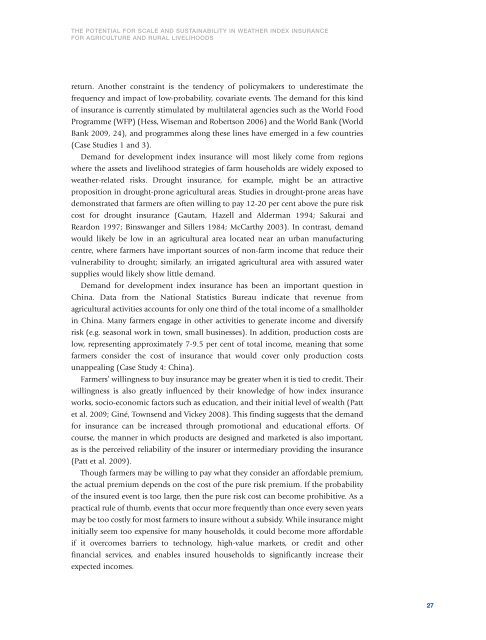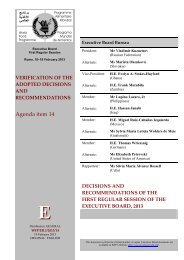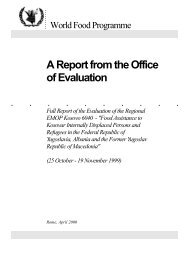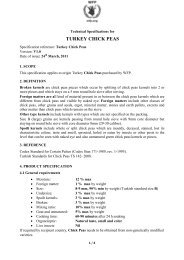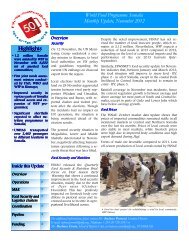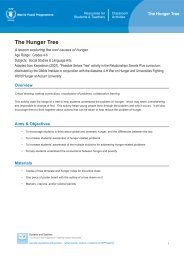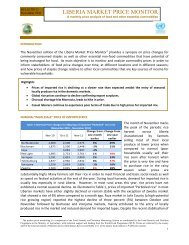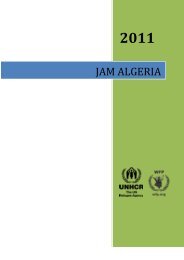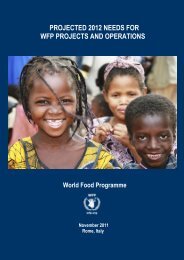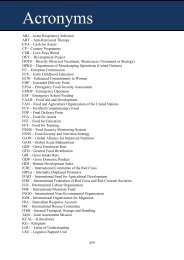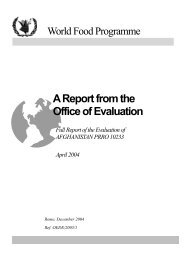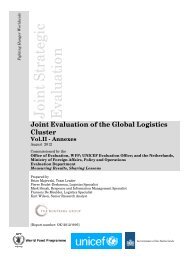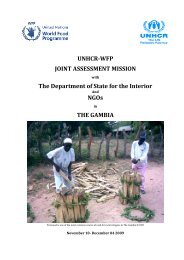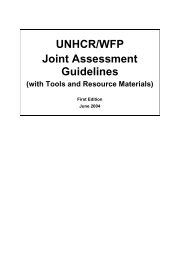The Potential for Scale and Sustainability in Weather Index Insurance
The Potential for Scale and Sustainability in Weather Index Insurance
The Potential for Scale and Sustainability in Weather Index Insurance
You also want an ePaper? Increase the reach of your titles
YUMPU automatically turns print PDFs into web optimized ePapers that Google loves.
THE POTENTIAL FOR SCALE AND SUSTAINABILITY IN WEATHER INDEX INSURANCE<br />
FOR AGRICULTURE AND RURAL LIVELIHOODS<br />
return. Another constra<strong>in</strong>t is the tendency of policymakers to underestimate the<br />
frequency <strong>and</strong> impact of low-probability, covariate events. <strong>The</strong> dem<strong>and</strong> <strong>for</strong> this k<strong>in</strong>d<br />
of <strong>in</strong>surance is currently stimulated by multilateral agencies such as the World Food<br />
Programme (WFP) (Hess, Wiseman <strong>and</strong> Robertson 2006) <strong>and</strong> the World Bank (World<br />
Bank 2009, 24), <strong>and</strong> programmes along these l<strong>in</strong>es have emerged <strong>in</strong> a few countries<br />
(Case Studies 1 <strong>and</strong> 3).<br />
Dem<strong>and</strong> <strong>for</strong> development <strong>in</strong>dex <strong>in</strong>surance will most likely come from regions<br />
where the assets <strong>and</strong> livelihood strategies of farm households are widely exposed to<br />
weather-related risks. Drought <strong>in</strong>surance, <strong>for</strong> example, might be an attractive<br />
proposition <strong>in</strong> drought-prone agricultural areas. Studies <strong>in</strong> drought-prone areas have<br />
demonstrated that farmers are often will<strong>in</strong>g to pay 12-20 per cent above the pure risk<br />
cost <strong>for</strong> drought <strong>in</strong>surance (Gautam, Hazell <strong>and</strong> Alderman 1994; Sakurai <strong>and</strong><br />
Reardon 1997; B<strong>in</strong>swanger <strong>and</strong> Sillers 1984; McCarthy 2003). In contrast, dem<strong>and</strong><br />
would likely be low <strong>in</strong> an agricultural area located near an urban manufactur<strong>in</strong>g<br />
centre, where farmers have important sources of non-farm <strong>in</strong>come that reduce their<br />
vulnerability to drought; similarly, an irrigated agricultural area with assured water<br />
supplies would likely show little dem<strong>and</strong>.<br />
Dem<strong>and</strong> <strong>for</strong> development <strong>in</strong>dex <strong>in</strong>surance has been an important question <strong>in</strong><br />
Ch<strong>in</strong>a. Data from the National Statistics Bureau <strong>in</strong>dicate that revenue from<br />
agricultural activities accounts <strong>for</strong> only one third of the total <strong>in</strong>come of a smallholder<br />
<strong>in</strong> Ch<strong>in</strong>a. Many farmers engage <strong>in</strong> other activities to generate <strong>in</strong>come <strong>and</strong> diversify<br />
risk (e.g. seasonal work <strong>in</strong> town, small bus<strong>in</strong>esses). In addition, production costs are<br />
low, represent<strong>in</strong>g approximately 7-9.5 per cent of total <strong>in</strong>come, mean<strong>in</strong>g that some<br />
farmers consider the cost of <strong>in</strong>surance that would cover only production costs<br />
unappeal<strong>in</strong>g (Case Study 4: Ch<strong>in</strong>a).<br />
Farmers’ will<strong>in</strong>gness to buy <strong>in</strong>surance may be greater when it is tied to credit. <strong>The</strong>ir<br />
will<strong>in</strong>gness is also greatly <strong>in</strong>fluenced by their knowledge of how <strong>in</strong>dex <strong>in</strong>surance<br />
works, socio-economic factors such as education, <strong>and</strong> their <strong>in</strong>itial level of wealth (Patt<br />
et al. 2009; G<strong>in</strong>é, Townsend <strong>and</strong> Vickey 2008). This f<strong>in</strong>d<strong>in</strong>g suggests that the dem<strong>and</strong><br />
<strong>for</strong> <strong>in</strong>surance can be <strong>in</strong>creased through promotional <strong>and</strong> educational ef<strong>for</strong>ts. Of<br />
course, the manner <strong>in</strong> which products are designed <strong>and</strong> marketed is also important,<br />
as is the perceived reliability of the <strong>in</strong>surer or <strong>in</strong>termediary provid<strong>in</strong>g the <strong>in</strong>surance<br />
(Patt et al. 2009).<br />
Though farmers may be will<strong>in</strong>g to pay what they consider an af<strong>for</strong>dable premium,<br />
the actual premium depends on the cost of the pure risk premium. If the probability<br />
of the <strong>in</strong>sured event is too large, then the pure risk cost can become prohibitive. As a<br />
practical rule of thumb, events that occur more frequently than once every seven years<br />
may be too costly <strong>for</strong> most farmers to <strong>in</strong>sure without a subsidy. While <strong>in</strong>surance might<br />
<strong>in</strong>itially seem too expensive <strong>for</strong> many households, it could become more af<strong>for</strong>dable<br />
if it overcomes barriers to technology, high-value markets, or credit <strong>and</strong> other<br />
f<strong>in</strong>ancial services, <strong>and</strong> enables <strong>in</strong>sured households to significantly <strong>in</strong>crease their<br />
expected <strong>in</strong>comes.<br />
27


